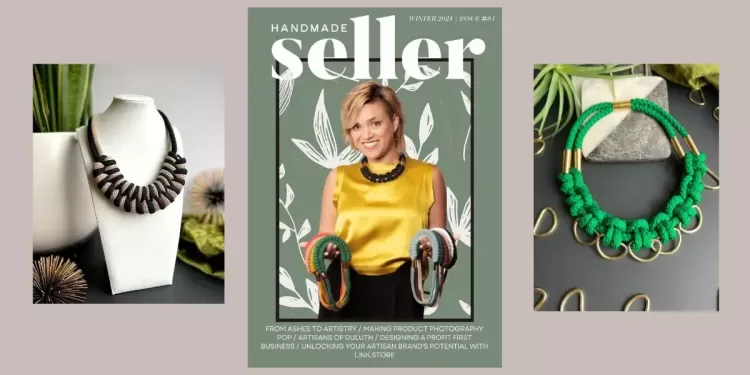I am currently reading a book by Ellen Ruppel Shell called “Cheap: The High Price of Discount Culture”. It’s a very interesting report piece on how our society has been transformed by our obsession with low prices.
From everyday offers (two for one, 40% off, 15% off your first order, etc.) to themed promotions (Valentine’s, Back to School, and the king of them all: Black Friday), there seems to always be a reason to discount products if one chooses to do so.
Whether that’s sustainable for our society at large is a conversation we won’t have time to get into today (my opinion in one word is, “no” (and you should definitely read Ellen’s book if you’re interested in a deep-dive) but since Black Friday and the craziness that is the fourth trimester in the retail world is around the corner… it could be a good idea to discuss discounting your handmade products.
Is it problematic? Or a marketing necessity? Let's dive in!
Discount culture was never pushed on us by “the little guys” (you and I!). It was a direct consequence of industrialization, mass-production, and globalization which allowed “the big guys” (Target, Kmart, Walmart, etc) to get their cost of production so incredibly low it suddenly was possible for them to compete on price aggressively.
The magic lies in what economists call “Economies of Scale” which is cost advantages that enterprises obtain due to their scale of operation(Wikipedia).”
Put simply, the more products they manufacture, the cheaper it becomes to produce them.
Small shops and artisans, by definition, do not have a “scale of operation.” Sure you can order your supplies in bulk if you create more products but that’s about the extent of it because anything handmade takes time… and we don’t have a machine to stretch time yet (at least not that I know of).
You can only go as fast as your hands allow, and that’s the beauty of the handmade culture! What makes handmade “handmade” is that products created by hand are inherently produced in small batches and can not be scaled past a certain point.
This is their uniqueness, this is why they’re valuable. Can you see the problem we’re running into here?
As a handmade seller, trying to imitate the discount strategies of bigger stores and manufacturers is a downward spiral, a race to the bottom you must avoid at all costs.
You can’t compete on your price, that’s never going to be a profitable or sustainable option as an artisan/maker/handmade seller.
You must do the exact opposite and compete on value.
Understanding (deeply, really understanding) what “perceived value” is and the difference between “objective value” and “subjective value” and how it affects your pricing and marketing strategies is the most important thing you can do to ensure your handmade business is successful. If you’d like to learn more about that, check out this video.
So, does it mean that you can’t or shouldn’t use discounts to promote and sell your handmade products?
No, not necessarily.
Your ideal customers, the people who shop handmade for the right reasons, who truly value your craftsmanship, and who want to support small shops are not looking for a bargain.
In fact, studies show that discounting your products repetitively can hurt your brand’s perceived value, meaning that in the eyes of your customers, your products are worth less than what they actually are, because they’ve been exposed to too many discounts, promotions, and sales. This can create a lack of trust in your brand and can, in the long term, really hurt your sales.
BUT your customers (even those ideal ones!) live in the same world as you and I, and, it’s a world reigned by discount culture. We are all used to seeing discounted prices and they can be hard to resist. A discount can gently push someone and turn her/him into a customer. They can also be a helpful way to move stock and inventory.
So, how can we reconcile those two worlds (discount culture and handmade production)? By being careful and strategic with how you use discounts.

Here Are My Top 4 Tips
1) The Rule That Rules Them All: You must have absolute clarity on your numbers.
Never, ever discount a product if you don’t know exactly what it costs to make the item (what is your exact profit margin for that item?).
You need to be ULTRA clear on your pricing structure for each item so that you know exactly how many more sales you’d need to make up for the loss in profit due to the discounted price OR if you can even afford the discount.
You wouldn’t believe how many makers I work with that do not have clarity on their numbers and end up losing money when running promotions because they’re not sure what their profit margins are and how they are affected.
2) How important will "discounts" be in your strategy overall?
This is also too often an afterthought. It often goes like this: You set your prices and think that most of the time that’s the price people will pay for your products, but in reality… most of your sales through the year come from promotions you are running.
Maybe you sell jewelry and most of your sales (say 65% of your total yearly sales) are coming through around Valentine’s Day and towards the end of the year around the holiday season when people are shopping for gifts.
That’s not an issue in itself, except if you always discount your products for those events. If you’re always discounting for events, 65% of the time you’re not making the profit margin you really wanted on those products when you initially set your prices.
That’s why it’s important to take some time to think about how often you will be discounting your products throughout the year and at around what percentage, so you can reflect this in your full retail price.
You should not be losing money when discounting your products. What you’re discounting is the price, not your profit margins. 😉
3) The "More Value for the Same Price" Alternative
Typically, the regular “$OFF” or “%OFF” discounts decrease the perceived value of products.
In the eyes of the customers, the product is suddenly “only worth” $X. For those of you wanting to develop a high-end, luxury brand, this can damage the brand and product reputation over time. Discounts are also proven to be highly addictive and if you do it too often customers will never buy full price again.
If you’d like to try something different, think about doing the opposite and adding perceived value, rather than decreasing it.
How? Give something extra away, instead of reducing the price.
For example, if you were to discount your product ($10 OFF) and you were to “lose” $10 on average with each order during that promotion … how about you spend that $10 on giving them a free gift?
Let’s say you sell wallets and purses, can you give away a key ring with orders? That’s added value for your customers, which can help you not only get more sales but also increase the perceived value of your brand and products in the eyes of your customers.
4) Set Some Strategic Rules
Finally, remember that you can set some rules as to how and when a discount can be applied. You’re the boss, after all. 😉
For example, you might want to avoid discounting the very first order so as to avoid giving first-time customers the impression that your products are often discounted and instead keep discounts as a way to encourage customers to become repeat customers and buy from you again (“thank you for your order, here’s $X off on your next one.”).
OR you might decide that actually discounting the first order is best because your shop’s visitors need that gentle push but once they buy once they don’t need any discounts to be convinced to buy again!
You can also decide to offer a discount only above a certain amount (get $20 OFF when you spend over $150) to protect your margins and to use the discount as a way to increase your average order value.

Interested in a subscription to the magazine?
Interested in a digital or print subscription to our quarterly magazine? Or are you interested in reading back issues of the magazine?







